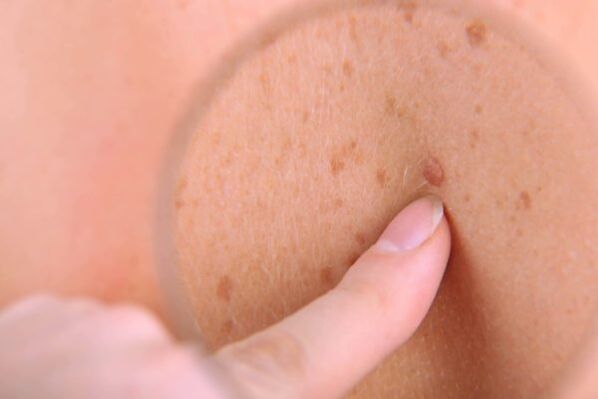The presence of such growths is associated with the presence of HPV in a person. They may not remind you of themselves for a long time.

Reasons for appearance
The cause of warts is the papillomavirus, which causes papillomatosis. Such a growth on the skin occurs in the presence of provoking factors:
- congenital or acquired immunodeficiency;
- stressful situations;
- flu;
- use of cytotoxic drugs;
- long-term use of antibiotics, hormones, non-steroidal anti-inflammatory drugs;
- chronic form of vitamin deficiency;
- persistent urinary tract infections;
- the presence of herpes virus inside the body.

Attention! The presence of HPV in a person does not guarantee the formation of tumors.
Risk subgroups
Papillomavirus is seen in the bloodstream of approximately 85% of the population. Many people do not realize that they are carriers of the virus, as HPV is latent and does not show outward signs. People with weakened immune systems due to previous illnesses, pregnancy and diabetes are at risk.
In addition, those who use drugs that suppress the immune system are vulnerable to infection. Those who often change roommates are also at great risk.
Routes of infection
There are 3 types of HPV infection:
- Sexual. It is the most popular method of infection, regardless of the type of sex. The virus is also spread by kissing. It penetrates the mucous membrane of the genitals and enters the body microscopically. The infection can live in it for a long time.
- Intrapartum. Infection occurs from mother to child at birth. During this time, the baby may develop oral colic and birth growth.
- Domestic. It rarely spreads on contact. It enters the body through micro-cracks in the skin. This happens when people share personal hygiene products.
But by eliminating these methods of infection, pathology can be prevented.
Symptoms of papillomas
HPV manifests itself in different ways and has the following characteristics:
- is located inside the body without new growth forming on the skin. In such a situation, the doctor diagnoses a hidden form of pathology. Pathogens without skin manifestations can be detected by PCR;
- formed as growths on the skin in the episomal form of the virus;
- promote the degeneration of epithelial cells from benign tumors into tumors.
What do condylomas look like?
Condylomas are tumors of the skin and mucous membranes that are inflammatory in nature. They have the following classification:
- broad with a broad base;
- pointed to a thin stem. They often appear on the skin of the genitals and in the armpits. Sometimes located in the corners of the mouth.
It is recommended to remove condylomas at the first stage of their development. Only in such conditions is it most likely to eliminate the pathology once and for all. Conservative treatment methods often do not give the desired results.
Symptoms and signs
Symptoms of HPV depend on the underlying cause. The disease has no general clinical symptoms. But the following signs stand out:
- the formation of growth;
- skin irritation;
- discomfort during intercourse;
- redness and itching.
Attention! Skin irritation and itching sometimes indicate other pathologies. If such symptoms occur, you should immediately contact a doctor.
The main difference
During the visual external examination, as well as when determining the type, many patients, without experience, confuse one type of wart with another. They are divided into two types:
- Papillomas - have a round or filiform shape with a thin base.
- Condylomas are growths with an irregular shape. Their uneven contours usually protrude 0. 5 cm above the skin.
Unlike papillomas, condylomas often develop on the dermis near the genitals, on the labia and foreskin of the penis. They look darker in color and their formation confirms the presence of HPV pathogens in the body.
Analysis
The following diagnostic measures are known to identify the type of growth on the skin. These include:
- visual inspection;
- PCR, which makes it possible to determine the presence of HPV;
- genotype. Analysis that identifies the type of virus;
- histological analysis. Allows you to accurately determine the type of pathology, as well as the likelihood of malignancy.
Treatment methods
Under no circumstances should you remove warts on your own. Before the operation to remove the growth, doctors recommend the following measures:
- take antiviral drugs. This makes it possible to suppress HPV activity;
- improve the function of the immune system - take vitamins and immunomodulators.
Treatment must be prescribed by a treating physician.
Hardware removal
Skin tumors can be eliminated in the following way:
- Surgery. Until recently, it was the main way to eliminate tumors. After the crust falls off, a scar forms in the affected area. This prompted experts to look for other methods of growth removal.
- Material. Special drugs containing strong acids are used to burn off warts.
- Cryocoagulation. The growth is frozen with liquid nitrogen at a low temperature. The increased risk of relapse is a significant disadvantage of using this method.
- Radio waves. It is painless and quick.
- Using a laser. One of the newest ways to eliminate skin growth. Not suitable for all warts.
Wart removal methods directly depend on the severity of the pathology, other diseases, immunity and other factors. Only based on these indications, the doctor can prescribe a specific method of excision.
Possible complications
If there is no treatment for the pathology, the chances of further infection increase, as a result, growths can spread to other areas of the skin and significantly weaken the immune system. Such growths are dangerous because they cause complications:
- formation of papillomas, condylomas and warts;
- papillomatosis. Excessive growth of tumors;
- period. Usually after the mechanism has been removed papillomas;
- infection. When a tumor is injured, the chance of infection increases;
- suppuration of tumors;
- ulcers Formed by prolonged friction against clothing;
- pre-cancer;
- cancerous growths inside the body;
- risk of skin cancer;
- suffocation in childhood. When the larynx is affected by papillomas, breathing difficulties often occur. There is a risk of suffocation.
Important! Human papillomavirus is a serious pathology. It is impossible to ignore it and engage in independent treatment. Otherwise, the disease may worsen.















































































